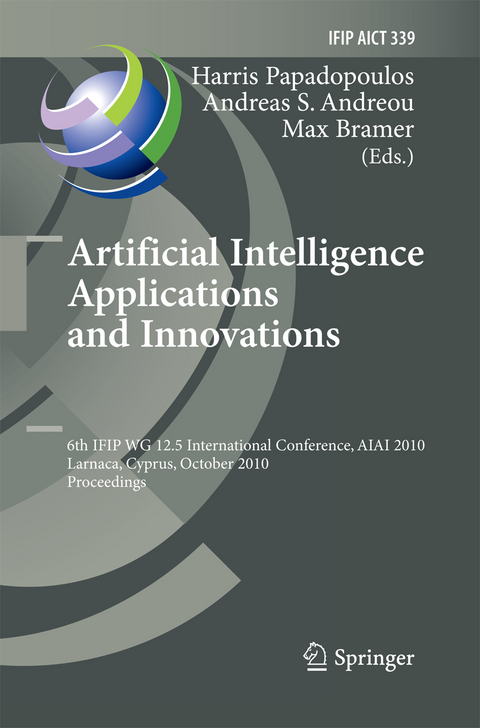
Artificial Intelligence Applications and Innovations
Springer Berlin (Verlag)
978-3-642-42361-1 (ISBN)
Invited Talks.- How Artificial Intelligence May Be Applied in Real World Situations.- Modern Machine Learning Techniques and Their Applications to Medical Diagnostics.- Innovative Applications of Artificial Intelligence Techniques in Software Engineering.- Machine Learning.- Linear Probability Forecasting.- The Importance of Similarity Metrics for Representative Users Identification in Recommender Systems.- An Optimal Scaling Approach to Collaborative Filtering Using Categorical Principal Component Analysis and Neighborhood Formation.- A Classroom Observation Model Fitted to Stochastic and Probabilistic Decision Systems.- Prediction with Confidence Based on a Random Forest Classifier.- Fuzzy Logic Techniques.- A Generic Tool for Building Fuzzy Cognitive Map Systems.- A Fuzzy Rule-Based Approach to Design Game Rules in a Mission Planning and Evaluation System.- One-Dimensional Linear Local Prototypes for Effective Selection of Neuro-Fuzzy Sugeno Model Initial Structure.- Lasso: Linkage Analysis of Serious Sexual Offences.- Evolutionary Computation.- Forecasting Euro - United States Dollar Exchange Rate with Gene Expression Programming.- Automatically Designing Robot Controllers and Sensor Morphology with Genetic Programming.- Multiple Criteria Performance Analysis of Non-dominated Sets Obtained by Multi-objective Evolutionary Algorithms for Optimisation.- Efficiency and Robustness of Three Metaheuristics in the Framework of Structural Optimization.- Medical Informatics and Biomedical Engineering.- A Fuzzy Non-linear Similarity Measure for Case-Based Reasoning Systems for Radiotherapy Treatment Planning.- A Soft Computing Approach for Osteoporosis Risk Factor Estimation.- Protein Secondary Structure Prediction with Bidirectional Recurrent Neural Nets: Can WeightUpdating for Each Residue Enhance Performance?.- Contourlet Transform for Texture Representation of Ultrasound Thyroid Images.- Assessment of Stroke Risk Based on Morphological Ultrasound Image Analysis with Conformal Prediction.- Text Mining and Natural Language Processing.- Concept Based Representations as Complement of Bag of Words in Information Retrieval.- Information Fusion for Entity Matching in Unstructured Data.- An Example-Tracing Tutor for Teaching NL to FOL Conversion.- Learning the Preferences of News Readers with SVM and Lasso Ranking.- Knowledge Representation and Reasoning.- A Comparison of Two Ontology-Based Semantic Annotation Frameworks.- A Tool for Automatic Creation of Rule-Based Expert Systems with CFs.- Non-standard Reasoning Services for the Verification of DAML+OIL Ontologies.- Algorithms for the Reconciliation of Ontologies in Open Environments.- Knowledge-Based Support for Software Engineering.- Planning and Scheduling.- A Hybrid Searching Method for the Unrelated Parallel Machine Scheduling Problem.- Aiding Interactive Configuration and Planning: A Constraint and Evolutionary Approach.- Decentralized Services Orchestration Using Intelligent Mobile Agents with Deadline Restrictions.- Mobile Robot-Assisted Cellular Environment Coverage.- Feature Selection and Dimensionality Reduction.- A Novel Feature Selection Method for Fault Diagnosis.- Dimensionality Reduction for Distance Based Video Clustering.- Towards Stock Market Data Mining Using Enriched Random Forests from Textual Resources and Technical Indicators.- On the Problem of Attribute Selection for Software Cost Estimation: Input Backward Elimination Using Artificial Neural Networks.- Engineering Intelligent Systems.- A Fast Mobile Face Recognition System for Android OS Based on Eigenfaces Decomposition.- Application of Conformal Predictors to Tea Classification Based on Electronic Nose.- Detecting and Confining Sybil Attack in Wireless Sensor Networks Based on Reputation Systems Coupled with Self-organizing Maps.- Statistical Fault Localization with Reduced Program Runs.- Fuzzy Cognitive Map for Software Testing Using Artificial Intelligence Techniques.- Intelligent User Environments and HCI.- Learning User Preferences in Ubiquitous Systems: A User Study and a Reinforcement Learning Approach.- Decision Oriented Programming in HCI: The Multi-Attribute Decision Language MADL.- Investigating the Role of Mutual Cognitive Environment for End-User Programming.- On the Quantification of Aging Effects on Biometric Features.- Environmental Modeling.- Fuzzy Inference Systems for Automatic Classification of Earthquake Damages.- A Fuzzy Inference System Using Gaussian Distribution Curves for Forest Fire Risk Estimation.- Evolutionary Prediction of Total Electron Content over Cyprus.- A Multi-layer Perceptron Neural Network to Predict Air Quality through Indicators of Life Quality and Welfare.
| Erscheint lt. Verlag | 13.11.2014 |
|---|---|
| Reihe/Serie | IFIP Advances in Information and Communication Technology |
| Zusatzinfo | XVI, 404 p. |
| Verlagsort | Berlin |
| Sprache | englisch |
| Maße | 155 x 235 mm |
| Gewicht | 640 g |
| Themenwelt | Schulbuch / Wörterbuch ► Unterrichtsvorbereitung ► Unterrichts-Handreichungen |
| Informatik ► Datenbanken ► Data Warehouse / Data Mining | |
| Mathematik / Informatik ► Informatik ► Grafik / Design | |
| Informatik ► Theorie / Studium ► Künstliche Intelligenz / Robotik | |
| Sozialwissenschaften ► Pädagogik | |
| Schlagworte | Artificial Intelligence • Evolution • evolutionary computation • Fuzzy Logic • Knowledge • Knowledge Representation • learning • machine learning • Modeling |
| ISBN-10 | 3-642-42361-2 / 3642423612 |
| ISBN-13 | 978-3-642-42361-1 / 9783642423611 |
| Zustand | Neuware |
| Informationen gemäß Produktsicherheitsverordnung (GPSR) | |
| Haben Sie eine Frage zum Produkt? |
aus dem Bereich


